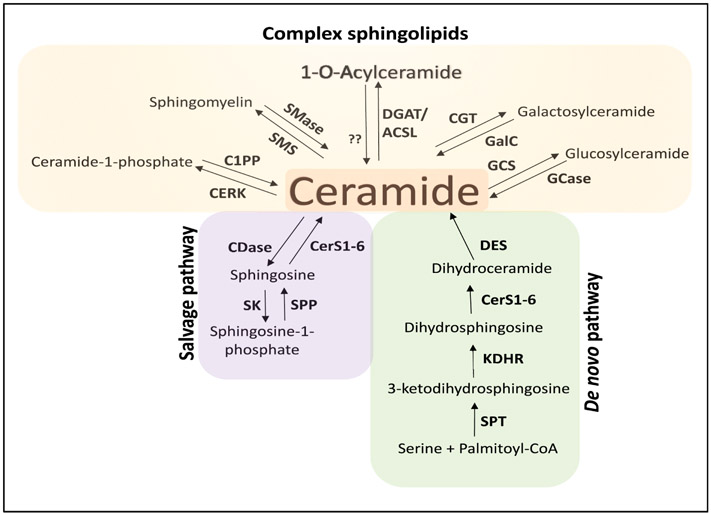Figure 1. Sphingolipid metabolism.
Ceramide is the hub of the sphingolipid metabolism and can be synthesized by several pathways. Ceramide can be generated by the de novo pathway (green box) from the condensation of serine and palmitoyl-CoA to generate 3-ketodihydrosphingosine, which is then reduced to dihydrosphingosine and further N-acylated to form dihydroceramide by (dihydro)ceramide synthases (CerS). Dihydroceramide desaturase (DES) then forms ceramide.
Ceramide can be hydrolyzed to sphingosine and then re-acylated back to ceramide in the salvage/recycling pathway (purple box) or phosphorylated to sphingosine-1-phosphate by sphingosine kinase (SK).
Ceramide can be also modified to form more complex sphingolipids (yellow box) such as ceramide-1-phosphate, sphingomyelin, hexosylceramdies (glucosylceramide and galactosylceramide) and O-acylceramides. Serine palmitoyltransferase (SPT); 3-ketodihydrosphingosine reductase (KDHR); ceramidase (CDase); sphingosine kinase (SK); sphingosine-1-phosphate phosphatases (SPP); ceramide kinase (CERK); ceramide-1-phosphate phosphatase (C1PP) sphingomyelinases (SMase); sphingomyelin synthase (SMS); glucosylceramide synthase (GCS); glucosylceramidase (GCase); ceramide galactosyltransferase (CGT); galactosylceramidase; fatty acyl-CoA synthase (ACSL); acyl-CoA:diacylglycerol acyltransferase (DGAT2)

